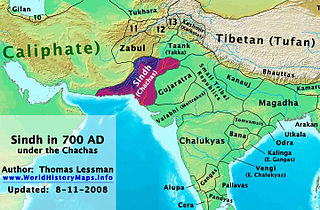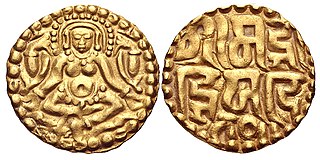Related Research Articles

The Gurjara-Pratihara was a dynasty that ruled much of Northern India from the mid-8th to the 11th century. They ruled first at Ujjain and later at Kannauj.

Mihira Bhoja or Bhoja I was the Pratiharan Emperor from 836 to 885 CE. He inherited a weakened realm in an adverse situation from his father, Ramabhadra. However, his capable reign transformed it into a large and prosperous empire. Bhoja was a devotee of Vishnu and adopted the title of Ādivarāha, which is inscribed on some of his coins.. One of the outstanding political figures of India in the ninth century, he ranks with Dhruva Dharavarsha and Dharmapala as a great general and empire builder.
Nagabhata II was an Indian Emperor from Gurjara-Pratihara dynasty. He ascended the throne of Gurjara-Pratihara dynasty after his father Vatsraja. His mother was queen Sundari-Devi. He was designated with imperial titles - Paramabhattaraka, Maharajadhiraja, and Paramesvara after conquest of Kannauj.
Nagabhata I was the founder of the imperial Gurjara Pratihara dynasty in northern India. He ruled the Avanti region in present-day Madhya Pradesh, from his capital at Ujjain. He may have extended his control over Gurjaradesa, which includes parts of present-day Gujarat and Rajasthan. He repulsed an Arab invasion from Sindh, probably led by Junayd ibn Abd al-Rahman al-Murri or Al Hakam ibn Awana.
Bhinmal is an ancient town in the Jalore District of Rajasthan, India. It is 72 kilometres (45 mi) south of Jalore. Bhinmal was the early capital of Gurjaradesa, comprising modern-day southern Rajasthan and northern Gujarat. The town was the birthplace of the Sanskrit poet Magha and mathematician-astronomer Brahmagupta.

The Umayyad Dynasty came to rule the Caliphate in 661 CE, and during the first half of the 8th century CE, a series of battles took place in the Indian subcontinent between armies of the Umayyad Caliphate and Indian kingdoms situated to the east of the Indus river, subsequent to the Arab conquest of Sindh in present-day Pakistan during 711 – 713 CE.

The history of human settlement in the western Indian state of Rajasthan dates back to about 100,000 years ago. Around 5000 to 2000 BCE many regions of Rajasthan belonged as the site of the Indus Valley Civilization. Kalibangan is the main Indus site of Rajasthan, here fire altars have been discovered, similar to those found at Lothal.

The Tripartite Struggle, also known as The Kannauj Triangle Wars, for control of northern India took place in the ninth century, among the Gurjara-Pratihara Empire, the Pala Empire and the Rashtrakuta Empire.
Vatsaraja (780–800) or Vatsraja was an Emperor of the Gurjara-Pratihara dynasty in Northern India. He was grand-nephew of Nagabhata I and his mother was queen Bhuyikadevi. He was the first ruler of Rajasthan to win victories over the distant regions of Kanauj and Bengal. His extensive conquests mark the rise of the Imperial Gurjara-Pratiharas.
Ramabhadra (833–836) was an Indian king, of Gurjara Pratihara dynasty. According to Jain Prabhavakacarita, Nagabhata II was succeeded by Ramabhadra, sometimes also called Rama or Ramadeva. His mother's name was Istadevi. Ramabhadra had a brief reign of three years. He encountered many difficulties during his reign. From an inscription found at Gwalior, it is known that his empire extended to Gwalior.
Gurjaradesa,, or is a historical region in India comprising the eastern Rajasthan and northern Gujarat during the period of 6th–12th century CE. The predominant power of the region, the Gurjara-Pratiharas eventually controlled a major part of North India centered at Kannauj. The modern state of "Gujarat" derives its name from the ancient Gurjaratra.

The Kalachuris of Tripuri, also known the Kalachuris of Chedi, ruled parts of central India during 7th to 13th centuries. They are also known as the Later Kalachuris to distinguish them from their earlier namesakes, especially the Kalachuris of Mahishmati. Their core territory included the historical Chedi region, and their capital was located at Tripuri.
The origin of the Gurjara-Pratihara dynasty of India is a topic of debate among historians. The rulers of this dynasty used the self-designation "Pratihara" for their clan, but have been described as "Gurjara" by their neighbouring kingdoms. Only one particular inscription of a feudatory ruler named Mathanadeva mentions him as a "Gurjara-Pratihara".
The Pratiharas of Mandavyapura, also known as the Pratiharas of Mandore, were an Indian dynasty. They ruled parts of the present-day Rajasthan between 6th and 9th centuries CE. They first established their capital at Mandavyapura, and later ruled from Medantaka.
Durlabha-rāja I was an Indian ruler belonging to the Chahamana dynasty. He ruled parts of present-day Rajasthan in north-western India as a vassal of the Gurjara-Pratihara king Vatsaraja.
Govinda-raja, also known as Guvaka I, was an Indian king from the Shakambhari Chahamana dynasty. He ruled parts of present-day Rajasthan in north-western India as a vassal of the Gurjara-Pratihara emperor Nagabhata II.
Devarāja was a king from the Gurjara Pratihara dynasty of northern India. In the Barah inscription of his descendant Mihira Bhoja, Devaraja's name appears as Devashakti.
Āma was a medieval Indian king who ruled Kannauj and surrounding areas during the 8th and the 9th centuries. According to the Jain chronicles, he was the son and successor of Yashovarman.
Narasimha II was a ruler of the Vemulavada Chalukya dynasty of present-day Telangana, India. As a vassal of the Rashtrakuta king Indra III, he led an Rashtrakuta army against the Gurjara-Pratihara king Mahipala. According to his dynasty's records, he advanced as far as Ganges river in the north, forcing Mahipala to flee.
References
- 1 2 Baij Nath Puri 1957, p. 38.
- ↑ Vibhuti Bhushan Mishra 1966, p. 18.
Bibliography
- Vibhuti Bhushan Mishra (1966). The Gurjara-Pratīhāras and Their Times. S. Chand. OCLC 3948567.
- Baij Nath Puri (1957). The history of the Gurjara-Pratihāras. Munshiram Manoharlal. OCLC 2491084.